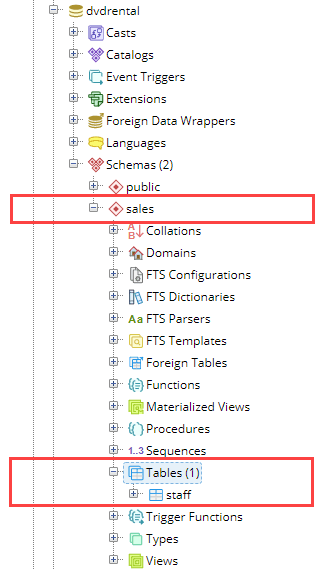Summary: in this tutorial, you will learn about PostgreSQL schema and how to use the schema search path to resolve objects in schemas.
Introduction to PostgreSQL schema
In PostgreSQL, a schema is a named collection of database objects, including tables, views, indexes, data types, functions, stored procedures, and operators.
A schema allows you to organize and namespace database objects within a database.
To access an object in a schema, you need to qualify the object by using the following syntax:
schema_name.object_nameA database may contain one or more schemas. However, a schema belongs to only one database. Additionally, two schemas can have different objects that share the same name.
For example, you may have sales schema that has staff table and the public schema which also has the staff table. When you refer to the staff table you must qualify it as follows:
public.staffOr
sales.staffSchemas can be very useful in the following scenarios:
- Schemas allow you to organize database objects e.g., tables into logical groups to make them more manageable.
- Schemas enable multiple users to use one database without interfering with each other.
The public schema
PostgreSQL automatically creates a schema called public for every new database. Whatever object you create without specifying the schema name, PostgreSQL will place it into this public schema. Therefore, the following statements are equivalent:
CREATE TABLE table_name(
...
);and
CREATE TABLE public.table_name(
...
);The schema search path
In practice, you will refer to a table without its schema name e.g., staff table instead of a fully qualified name such as sales.staff table.
When you reference a table using its name only, PostgreSQL searches for the table by using the schema search path, which is a list of schemas to look in.
PostgreSQL will access the first matching table in the schema search path. If there is no match, it will return an error, even if the name exists in another schema in the database.
The first schema in the search path is called the current schema. Note that when you create a new object without explicitly specifying a schema name, PostgreSQL will also use the current schema for the new object.
The current_schema() function returns the current schema:
SELECT current_schema();Here is the output:
current_schema
----------------
public
(1 row)This is why PostgreSQL uses public for every new object that you create.
To view the current search path, you use the SHOW command in psql tool:
SHOW search_path;The output is as follows:
search_path
-----------------
"$user", public
(1 row)In this output:
- The
"$user"specifies that the first schema that PostgreSQL will use to search for the object, which has the same name as the current user. For example, if you use thepostgresuser to log in and access thestafftable. PostgreSQL will search for thestafftable in thepostgresschema. If it cannot find any object like that, it continues to look for the object in thepublicschema. - The second element refers to the
publicschema as we have seen before.
To create a new schema, you use the CREATE SCHEMA statement:
CREATE SCHEMA sales;To add the new schema to the search path, you use the following command:
SET search_path TO sales, public;Now, if you create a new table named staff without specifying the schema name, PostgreSQL will put this staff table into the sales schema:
CREATE TABLE staff(
staff_id SERIAL PRIMARY KEY,
first_name VARCHAR(45) NOT NULL,
last_name VARCHAR(45) NOT NULL,
email VARCHAR(100) NOT NULL UNIQUE
);The following picture shows the new schema sales and the staff table that belongs to the sales schema:
 To access the
To access the staff table in the sales schema you can use one of the following statements:
SELECT * FROM staff;and
SELECT * FROM sales.staff;The public schema is the second element in the search path, so to access the staff table in the public schema, you must qualify the table name as follows:
SELECT * FROM public.staff;If you use the following command, you will need to explicitly refer to objects in the public schema using a fully qualified name:
SET search_path TO public;The public schema is not a special schema, therefore, you can drop it too.
PostgreSQL schemas and privileges
Users can only access objects in the schemas that they own. It means they cannot access any objects in the schemas that do not belong to them.
To allow users to access the objects in the schema that they do not own, you must grant the USAGE privilege of the schema to the users:
GRANT USAGE ON SCHEMA schema_name
TO role_name;To allow users to create objects in the schema that they do not own, you need to grant them the CREATE privilege of the schema to the users:
GRANT CREATE ON SCHEMA schema_name
TO user_name;Note that, by default, every user has the CREATE and USAGE on the public schema.
PostgreSQL schema operations
- To create a new schema, you use the
CREATE SCHEMAstatement. - To rename a schema or change its owner, you use the
ALTER SCHEMAstatement. - To drop a schema, you use the
DROP SCHEMAstatement.
Summary
- A schema is a named collection of database objects, including tables, views, indexes, sequences, and so on.
- Use schemas to organize and namespace these objects within a database.
- Use the search path to resolve object names.